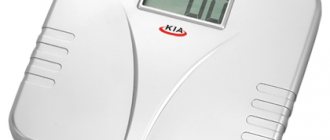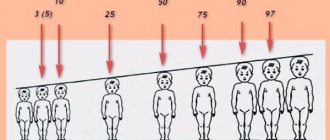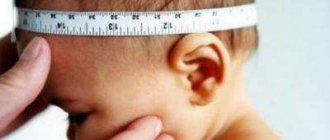The head circumference of a newborn is one of the most important parameters by which the correct development of the baby in the first year of his life is monitored. Head circumference is measured by a pediatrician in a children's clinic. The doctor compares data on the size of the newborn’s head with the norms established for each age and reflected in a special table.
Carrying out regular measurements allows you to timely identify pathologies in the baby's development . For example, if the head grows too quickly, this may indicate the development of hydrocephalus (hydrocephalus), and if it grows too slowly, then microcephaly. That is why a schedule of visits to the pediatrician is established for each child to conduct an examination and take metric indicators.
Newborn head shape
While passing through the mother’s birth canal, the baby experiences strong pressure on the bones of the skull, which are still soft enough to take the necessary shape and “adapt” to the anatomical features of the mother’s pelvic organs.
When the baby's head drops lower and lower towards the entrance to the pelvis, it can also change its shape somewhat and stretch out so that the baby can be born. As a result, immediately after birth, the baby has an oblong head shape, elongated upward.
Parents should not worry about this feature, as this is quite normal, and after a couple of weeks the head will take on a standard shape.
The skull bones of a newly born baby still retain their mobility - this also should not frighten the young mother, since thanks to this the child avoids injury and does not get stuck in the birth canal.
If the baby was born by caesarean section
In children born through surgery, not only the shape of the head, but also its size, will be somewhat different from babies born naturally.
The period of removal of the baby from the uterus during a cesarean section is about 5-10 minutes, while the baby does not experience pressure (as happens during natural childbirth, when the baby passes through the birth canal). That is why the head of “Caesarean babies” is smooth, has no signs of birth deformation and convex areas at the temples.
The head size of children born as a result of cesarean section will slightly exceed age norms. The pediatrician must take this feature into account when examining the baby in order to draw the correct conclusions about his state of health.
Why is it necessary to measure the head circumference of children under one year of age every month?
A newborn baby cannot support his head on his own, since the neck muscles are still too weak to support such weight. In the first weeks of his life, the baby will only throw his head back, so it is important to support it when parents or any of the relatives take the baby in their arms.
To train the neck muscles, the child should be placed on his tummy: the baby will try to lift his head from the surface on which he lies, and as the muscles and ligaments strengthen, he will gradually hold it in weight.
By 1 month, children can confidently hold their head up for 10-15 seconds, and by 3 months they can already look around independently. During this period, the volume of the head increases by about 4 cm, and its shape is finally leveled out.
If the child's head circumference is less or more than the established norms, the child needs a thorough examination, as this may indicate serious pathologies and mental retardation.
For the first time, the head circumference of a newborn is measured immediately after birth, after which this indicator should be monitored monthly by the pediatrician and parents for early detection of possible problems and pathologies.
Can heredity affect head size?
Scientists have long proven that a genetic factor can also influence the volume of the head at the time of birth. If mom or dad had non-standard sizes during infancy, but at the same time developed according to age, the likelihood that the child will have slight deviations from normal values is about 23%.
There is no need to worry if the child is not physically and intellectually retarded in development, and the doctor does not see behavioral or other deviations.
Head size as an indicator of child development and health
The head circumference of a newborn is one of the main indicators of brain development
The head circumference of a newborn is one of the main indicators of brain development. They are checked immediately after birth, then the dimensions are monitored by the pediatrician at monthly examinations. In obstetrics and pediatrics, there are special centile tables of child head sizes by age, which show what values are normal.
With the help of regular monitoring of changes in the circumference of the skull, it is possible to timely determine the onset of the development of infectious diseases, nervous disorders, and pathologies of brain development.
Knowing the circumference of your head, it’s easy to buy a cap, bonnet, hat, focusing on the size charts. You need to select a headdress taking into account the circumference of the skull and depth. Otherwise, the cap will slip off your ears or fit over your eyes.
When measuring the parameters of the skull, it is necessary to take into account what week the child was born, body weight and height at birth, and individual characteristics.
How to find out head circumference: measurement technique
You can measure the circumference of a child’s head at a pediatrician’s appointment or at home yourself, usually using a (soft) centimeter tape.
It is important that the baby is in a calm state and does not cry, otherwise the measurement results may be inaccurate. The ideal time to measure a child is during the daytime nap.
To find out your head circumference, follow these steps:
- wipe the centimeter with a disinfectant solution or antiseptic (for example, Chlorhexidine);
- wrap the ribbon around the child’s head (from the front along the eyebrow line, and from the back along the protrusion at the back of the head);
- Write down the result in a special notepad.
It is advisable to carry out such measurements every month and check them with the table in order to notice in time if something is wrong with the baby.
Table of head circumference for children under one year old
| Child's age | Head circumference, cm | ||||
| Critically low | Low | Norm | High | Critically high | |
| Newborn | 30,3 | 31,5 | 33,9 | 36,2 | 37,4 |
| 1 month | 33,0 | 34,2 | 36,5 | 38,9 | 40,1 |
| 2 months | 34,6 | 35,8 | 38,3 | 40,7 | 41,9 |
| 3 months | 35,8 | 37,1 | 39,5 | 42,0 | 43,3 |
| 4 months | 36,8 | 37,6 | 40,6 | 43,1 | 44,4 |
| 5 months | 37,6 | 38,9 | 41,5 | 44,0 | 45,3 |
| 6 months | 38,3 | 39,6 | 42,2 | 44,8 | 46,1 |
| 7 months | 38,9 | 40,2 | 42,8 | 45,5 | 46,8 |
| 8 months | 39,4 | 40,7 | 43,4 | 46,0 | 47,4 |
| 9 months | 39,8 | 41,2 | 43,8 | 46,5 | 47,8 |
| 10 months | 40,2 | 41,5 | 44,2 | 46,9 | 48,3 |
| 11 months | 40,5 | 41,9 | 44,6 | 47,3 | 48,6 |
| 1 year | 40,8 | 42,2 | 44,9 | 47,6 | 49,0 |
The values presented in the table are approximate and may differ depending on the individual characteristics of a particular child.
What to do if a pathology is detected?
The numerical interval of head circumference by 6 months should range from 41 to 44 cm in girls and from 42 to 45 cm in boys. If there are deviations, the neurologist should conduct an additional study of the baby’s health and prescribe an ultrasound scan of the brain: it will help to recognize the cause of underdevelopment or excessive growth. The mother needs to monitor how the child moves, how and how long he holds his head, and check his reflexes. Children who have been diagnosed with pathology need drugs that provide nutrition to the brain. They are prescribed only by a doctor if he sees a severe form of the pathology, but, as a rule, until the child is one year old, they only observe and establish hereditary diseases that are transmitted genetically.
Possible deviations
The normal head size for a newborn baby ranges from 35 to 37 cm. If deviations from these values exceed 1-1.5 cm, this may indicate serious problems or injury received by the child during childbirth.
Birth injury
Most often, a baby receives a birth injury for the following reasons:
- violation of the behavior technique during childbirth on the part of the mother (for example, when a woman tries to sit during the pushing period);
- malposition;
- discrepancy between the size of the woman’s pelvis and the child’s head circumference.
Birth injuries most often do not pose a life-threatening threat, and their consequences completely disappear when the child is 10-12 months old.
But in some cases, the results can be very sad, so women need to attend all routine examinations with a gynecologist to monitor the baby’s position.
We should not forget about correct behavior at the time of labor - sometimes it is the mother’s actions that lead to tragic abnormalities in the newborn’s cerebral circulation.
Hydrocephalus
This pathology is an accumulation of fluid in the brain space, which puts pressure on the brain and prevents it from growing and developing.
If detected early, hydrocephalus and its consequences can be successfully treated, but in advanced cases, the disease can lead to the death of the child.
Hydrocephalus can be suspected based on the following signs:
- head circumference exceeds the norm by 3-4 cm;
- the fontanelles and frontal bone are enlarged;
- the bones forming the skull diverge slightly;
- a venous pattern appears on the head.
Children with hydrocephalus are restless and often cry. This is due to the fact that the fluid puts pressure on the brain, which causes severe headaches in the child. If such a baby is shown to a pediatric neurologist, other neurological problems can be detected.
Microcephaly
True microcephaly (small brain) is extremely rare. It is impossible to make this diagnosis based solely on the size of the head, since this parameter can be influenced by various factors, including hereditary ones.
If microcephaly is suspected, the baby must undergo an ultrasound scan of the brain. Only after the study can we talk about pathologies.
Hemangioma
This is a benign brain tumor that looks like a birthmark. As a rule, hemangioma appears in the first 7-10 days of a newborn’s life. With timely treatment, the pathology does not pose a threat to life, but the child will require constant monitoring. In addition to the characteristic spot, with this type of tumor there will be an excess of the head circumference above normal values.
What deviations are considered dangerous?
Medical care, including diagnostic measures and a full examination, is required for the baby in cases where the head circumference exceeds (or, conversely, falls short of) the norm by 3-4 cm.
Such indicators almost always indicate severe pathologies for which the child should be placed under the supervision of specialists.
Deviations in brain development are one of the most serious pathologies encountered in pediatric practice.
It is possible to get by with minimal consequences only in cases where the child begins to receive the necessary treatment in a timely manner, so it is important to monitor how the little head grows every month until the child reaches one year of age.
Normal development of the cranium
A newborn baby is completely helpless. The size of the head is large compared to the body. During the first weeks, the baby will not be able to hold his head up on his own. Train your baby - lay him on his tummy and after a few days he will already stretch his neck and look at the space in front. One-month-old babies can already hold their heads up, but still require additional help from an adult.
At birth, the norm is considered to be a head circumference of 34-35 cm. In the first month, the volume increases by 2-3 cm. By two months, the increase occurs by 2 cm. The shape of the head is round and even. A three-month-old baby not only holds his head confidently, but also turns it around. From three months to one year, the increase is 1 cm per month. A one-year-old child has an average head volume of 47-49 cm.
The head circumference is compared to the chest. On average, a newborn has 2 cm more circumference of the head than the chest. The equalization of the sizes of the skull and chest occurs at four months. A one-year-old baby has 2 cm more chest volume compared to the head.
The pediatrician, observing the development of your baby, also records changes in the growth of the skull.
Good to know: growth dynamics can be traced from a month to a year. If deviations exist, corrective treatment is prescribed.
Upon reaching six months, the head volume in girls reaches 41-44 cm, and in boys from 42 to 46 cm.











